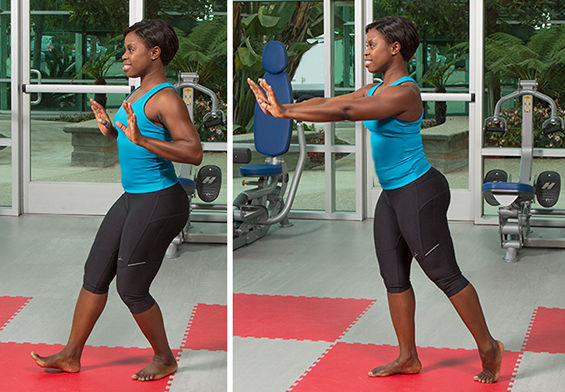
Individuals who are balance challenged, such as those with Parkinson's disease or multiple sclerosis, require a method of balance training that usually includes keeping two feet on the floor. Fusing Western, Eastern and somatic concepts, this well-rounded practice combines ancient postures with traditional exercise to meet the balance needs of individuals with special needs, from the feet to the brain.
Many personal training and group exercise sessions incorporate balance exercises into the routine. Balance training is used to increase the efficiency of single-leg pattern movements such as gait or standing on one foot. When the word “balance” comes to mind, trainers and instructors often think of unstable-surface equipment such as BOSUs, SPRI 360 and versa discs. Although these tools are highly effective, especially with active adults, special populations require a different method of balance training—a process that usually includes keeping two feet on the floor. Balance exercises, like any other exercise, must be progressed before incorporating highly unstable surfaces. In addition, balance training is more than a physical practice of balancing on one leg. It challenges the vestibular system, proprioception and brain; thus, the mind and body work as one unit.
What follows is a “wholistic” balance-training guide that fuses Western, Eastern and somatic concepts. This well-rounded practice combines ancient postures with traditional exercise to meet the balance needs of individuals with special needs, from the feet to the brain.
Who Can Benefit From Balance Training?
The term “special populations” is defined differently in various contexts. In terms of exercise, special populations typically refers to individuals who require special attention or care to address their condition, needs or ability. Generally, there are program alterations that differ for special populations compared to the average healthy adult or athlete. The balance exercises presented here are beneficial for everybody, but were specifically designed for individuals who have a movement disability or neurological disorder. Diseases and ailments result in physical, mental and emotional alterations. As a result, bodies experience motor weakness, sensory changes, visual disturbances, fatigue and sensitivity to heat or paralysis. From seniors and stroke survivors to individuals with Parkinson’s disease or multiple sclerosis, a wide range of special populations can benefit from mind-body balance training.
Key Components to Balance Training for Special Populations
The five following components can be used to help clients comprehend their training programs and progress. These components maybe used individually or together to further progress and regress balance exercises. This ensures that exercises are safe, achievable and enjoyable.
Awareness unites the brain and body connection and enhances focus and concentration. While being aware, clients are present in the moment and able to recognize breath patterns. Awareness is crucial to execute balance effectively, as stressed and fluttering minds distract from the task at hand. During awareness building, you can educate your clients on the foot’s triad, which are the points on the foot that form a triangle. This includes one point on the heel and two points on the medial and lateral ball of the foot.
Visual affect either assists or challenges balance, based on the visibility or focal point. Closing the eyes stimulates sensory receptors and proprioception. Partial or fully closed eyes help train the body for real-life situations such as fogged glasses, darkened room or visual impairments resulting from a stroke.
Balance challenge variables include:
- Partially closing the eyes (see eyelids)
- Closing one eye
- Closing both eyes
- Looking at a focal point
- Visual fixation on stationary target with head moving
- Visual fixation on moving target with head stationary
- Eye gaze moving with the head
External stimulus incorporates either equipment or perturbation into the exercise, and either challenges balance or promotes concentration and assistance. A Pilates ball, yoga strap or trainer’s touch may promote alignment or balance assistance. External stimulus combined with movement incorporates sensory stimulation with cognitive object concentration.
Contact point refers to anything that promotes balance while assisting the body or alignment. A chair, wall, body bar or a trainer’s shoulder can assist a client’s balance. Reducing contact points, such as lifting one foot off the floor or releasing one or both hands off the hips, challenges balance. Individuals with multiple sclerosis and Parkinson’s disease often have days that are better than others in terms of movement and balance. Therefore, some may require adding a contact point such a wall or ballet bar to hold onto while reducing the contact points of the foot.
Movement includes any small or large range of motion of one or more body parts. During balance training, a client may move his or her head, upper body or whole body. As a general rule of thumb, the more body parts that move, the more challenging the exercise becomes. In turn, movement can be used to progress from static to dynamic poses.
How to Safely Progress Balance
There are many ways to progress balance. Once you understand the concepts previously mentioned, they could be applied toward any balance exercise. With special populations, it is ideal to first start with a bilateral stance and help the client focus on his or her physical—or kinesthetic—awareness of the body in an upright position. Also, recognize the placement of the feett on the floor. To help clients gain further awareness, you can guide their foot movement, such as supination, pronation, dorsiflexion, plantarflexion and toe lifts. Once static foot positions have been achieved, you can incorporate additional balance challenge variables.
Bilateral Foot Stance
You can challenge a client’s bilateral foot stance by incorporating movement and visual affect to progress postures. The movement of the upper body and head will challenge proprioception, while closing the eyes incorporates the sensory organs and challenges the vestibular system.
Split Foot Stance
Split foot stances are less stable and can integrate external stimulus to assist in the balance exercise. Split foot stance balance exercises strengthen single-leg movement patterns such as gait, walking upstairs or running to catch a cab.
Unilateral Foot Stance
The release of a contact point off the floor enhances balance challenges. Some clients may need to place their hands on a chair or wall as a contact point to effectively execute a pose. When unilateral poses can be performed effortlessly, adding movements and visual affect will increase the balance challenge.
Five Balance-challenging Exercises

Mountain Pose with Eyes Closed
Purpose: Improves static postural control. With the reduction of vision, this exercise incorporates the vestibular and somatosensory systems.
How to Perform the Pose: Stand tall with your feet shoulder-width apart. Place your arms by your sides with palms facing forward. Close your eyes and bring attention and awareness to the posture, breath and placement of the feet. Hold for one to two minutes.
Progression Options: Move your feet into various positions (supination, pronation, dorsiflexion, plantarflexion and toe lifts). Stand on unstable surfaces or move the arms up and down overhead.

Chair Pose with Thoracic Spine Rotation
Purpose: Strengthens the lower extremities, while using all sensory systems combined with external stimulus and upper-extremity movement.
How to Perform the Pose: Stand with your legs together and lower the hips into a static squat position. Hold the Pilates ball in your left hand and rotate your body toward the left. Keep your eyes on the ball. Rotate to center and place the ball into your right hand and rotate the rib cage toward the right. Continue the movement for one to two minutes.
Progression: Rotate with one or both eyes closed.

Tai Chi Push-Pull
Purpose: Improves dynamic postural control while in a moving split-foot stance position.
How to Perform the Pose: Split the stance so that one foot is in front and place your hands in front of your chest. Slowly shift your weight onto the back leg, lifting the front toes, and then shift your weight forward, extending the arms and lifting the back heel off the floor. Complete for one to two minutes before switching sides.
Progression: Add rotation to the upper extremity in the same direction of the front leg, or gaze at a focal point and move the hands in front of the focal point to improve concentration (the moving object adds a distraction). You may also close one or both eyes.

Standing March
Purpose: Improves dynamic postural control and single-leg stance ability.
How to Perform the Pose: Stand erect with your abdominals engaged and hands on the hips. Slowly lift the right leg to 90 degrees and return back to center. Slowly lift the left leg to 90 degrees and continue this motion for one to two minutes.
Progression: Move from a stable to an unstable surface or raise arms to shoulder height or overhead. You may also choose to partially close your eyes.

Crane Heel Raises
Purpose: Increases lower-extremity strength, improves dynamic postural control and challenges concentration on a focal point.
How to Perform the Pose: Place feet together and stand erect with your abdominals engaged. Concentrate on a focal point on the floor or wall. Lift the right heel off the floor while raising the right arm to shoulder height. The hand should move past the eye gaze. Repeat on the left side and continue the movement for one to two minutes.
Progression: Lift both heels off the floor or raise both arms. You may also progress to lifting each leg to 90 degrees while lifting both arms to shoulder height.





 by
by 







